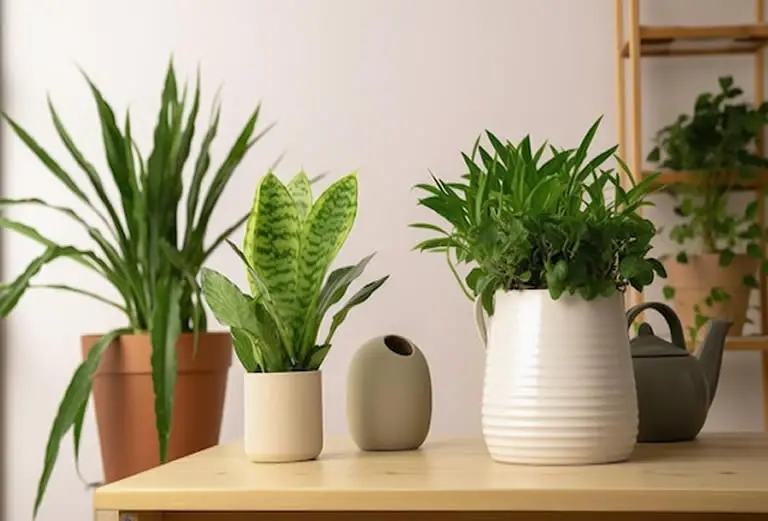Starting your indoor plant journey can feel overwhelming at first—so many plants, so many care tips! But don’t worry. You don’t need to be a horticulturist to grow a thriving indoor jungle. Some houseplants are naturally tough, adaptable, and incredibly forgiving—even if you miss a watering (or three).
Table of Contents
- Quick List of 30 Easy-Care Houseplants
- The 30 Easy-Care Houseplants Perfect for Beginners
- Aloe Vera
- Areca Palm (Dypsis lutescens)
- Cast Iron Plant (Aspidistra elatior)
- Chinese Evergreen (Aglaonema)
- Corn Plant (Dracaena fragrans)
- Dragon Tree (Dracaena marginata)
- English Ivy (Hedera helix)
- Fiddle Leaf Fig (Ficus lyrata)
- Golden Pothos (Epipremnum aureum)
- Hoya (Hoya carnosa and other varieties)
- Jade Plant (Crassula ovata)
- Lucky Bamboo (Dracaena sanderiana)
- Monstera Deliciosa
- Nerve Plant (Fittonia albivenis)
- Norfolk Island Pine (Araucaria heterophylla)
- Parlor Palm (Chamaedorea elegans)
- Peace Lily (Spathiphyllum)
- Peperomia (Peperomia spp.)
- Philodendron (Philodendron hederaceum and hybrids)
- Ponytail Palm (Beaucarnea recurvata)
- Prayer Plant (Maranta leuconeura)
- Rubber Plant (Ficus elastica)
- Snake Plant (Dracaena trifasciata)
- Schefflera (Umbrella Plant)
- Spider Plant (Chlorophytum comosum)
- Split Leaf Philodendron (Thaumatophyllum bipinnatifidum)
- String of Pearls (Senecio rowleyanus)
- Swiss Cheese Plant (Monstera adansonii)
- Syngonium (Arrowhead Plant)
- ZZ Plant (Zamioculcas zamiifolia)
- Dieffenbachia (Dumb Cane)
- Pilea Peperomioides (Chinese Money Plant)
Quick List of 30 Easy-Care Houseplants
Below is a list of all 30 easy-care houseplants that are perfect for beginners.
This is for reference and easy access. I do recommend you visit the section about each plant to discover their basic care needs and find out WHY that particular plant is prefect for beginner indoor gardeners.
-
Aloe Vera
-
Areca Palm (Dypsis lutescens)
-
Cast Iron Plant (Aspidistra elatior)
-
Chinese Evergreen (Aglaonema)
-
Corn Plant (Dracaena fragrans)
-
Dragon Tree (Dracaena marginata)
-
English Ivy (Hedera helix)
-
Fiddle Leaf Fig (Ficus lyrata)
-
Golden Pothos (Epipremnum aureum)
-
Hoya (Hoya carnosa)
-
Jade Plant (Crassula ovata)
-
Lucky Bamboo (Dracaena sanderiana)
-
Monstera Deliciosa
-
Nerve Plant (Fittonia albivenis)
-
Norfolk Island Pine (Araucaria heterophylla)
-
Parlor Palm (Chamaedorea elegans)
-
Peace Lily (Spathiphyllum)
-
Peperomia (Peperomia spp.)
-
Philodendron (Philodendron hederaceum or hybrids)
-
Ponytail Palm (Beaucarnea recurvata)
-
Prayer Plant (Maranta leuconeura)
-
Rubber Plant (Ficus elastica)
-
Sansevieria (Snake Plant / Dracaena trifasciata)
-
Schefflera (Umbrella Plant)
-
Spider Plant (Chlorophytum comosum)
-
Split Leaf Philodendron (Thaumatophyllum bipinnatifidum)
-
String of Pearls (Senecio rowleyanus)
-
Swiss Cheese Plant (Monstera adansonii)
-
Syngonium (Arrowhead Plant)
-
ZZ Plant (Zamioculcas zamiifolia)
The 30 Easy-Care Houseplants Perfect for Beginners
Whether you’re filling a sunny windowsill, greening up your bathroom, or just trying not to kill your first plant, this guide is for you.
These 30 easy-care houseplants are perfect for beginners. They’re low-maintenance, beautiful, and sure to build your plant-care confidence.
Let’s dive in—starting with a true classic.
Aloe Vera
If you’re new to houseplants and want something that’s both beautiful and hard to kill, Aloe Vera (like all aloe plants) is a brilliant place to start.
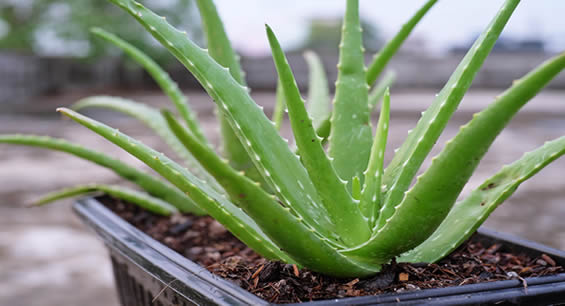
This popular succulent is incredibly low-maintenance, and it comes with a bonus: the gel inside its thick, fleshy leaves can be used to soothe minor burns and skin irritations.
Aloe Vera plants grow in a striking rosette formation, with bright green leaves that can reach up to 20 inches in length when mature.
It’s a slow-growing plant by succulent standards, but Aloe Vera is actually one of the fastest growers in its family—especially when it gets the care it loves.
Lighting needs
Aloe thrives in bright light and can handle full sun for 6 to 8 hours a day without complaint.
In fact, direct sunlight is where it grows best.
If you can place it near a south- or west-facing window, it’ll be right at home.
That said, it does tolerate partial shade in the late afternoon, which makes it adaptable to slightly less sunny spots as well.
Soil and watering
This is a desert plant at heart, so it needs sandy, fast-draining soil—nothing that holds onto water.
It’s best to let at least half of the potting mix dry out before watering again.
And when you do water, give it a deep, thorough soak rather than small, frequent sips.
Like most succulents, Aloe prefers to be dried out before getting drenched.
Be sure not to let water collect in the center of the rosette, as this can cause rot.
During winter, when growth slows, you can reduce watering even further.
The plant naturally goes semi-dormant in cooler months and doesn’t need as much moisture.
Why it’s great for beginners
Aloe Vera is one of the most forgiving houseplants out there. As long as you give it plenty of light, well-draining soil, and don’t overwater it, it will thrive with very little fuss.
Its ability to tolerate a bit of neglect and its attractive, practical foliage make it a top pick for new plant parents.
Areca Palm (Dypsis lutescens)
If you’re after a houseplant that brings a breezy, tropical feel to your home without the high maintenance, the Areca Palm is a fantastic choice.
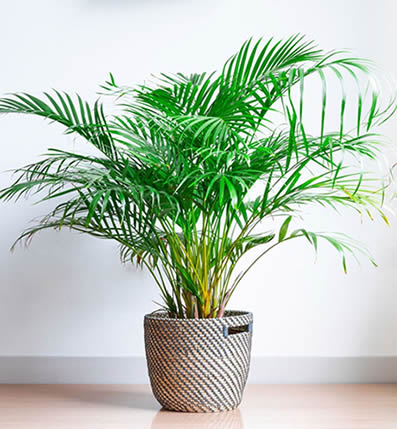
Also known as the Butterfly Palm or Golden Cane Palm, this graceful plant features feathery, arching fronds that look like they belong on a sunny beach—even if they’re sitting in your living room.
Areca Palms can grow several feet tall indoors, and when given the right care, they’ll fan out into a stunning clump of soft, golden-green foliage.
Below are the basic care needs of the Golden Pothos but if you want more detailed instructions read our article Golden Pothos Care: A Trailing Favorite That’s Almost Impossible to Kill.
Lighting needs
This palm thrives in bright, indirect light.
It will tolerate some direct morning sun, but harsh afternoon rays can scorch the leaves.
If the light is too low, growth may slow, and the plant can become leggy.
A spot near an east- or west-facing window is usually ideal.
Soil and watering
Plant your Areca Palm in a well-draining potting mix—something designed for palms or a standard houseplant mix amended with sand or perlite works well.
It likes the soil to stay lightly moist during the growing season, so water when the top inch feels dry. In winter, scale back slightly and let the top couple of inches dry out before watering again.
One thing this plant doesn’t like? Sitting in water. Always make sure the pot has drainage holes, and don’t let it stand in a saucer of water.
Humidity and temperature
Areca Palms prefer moderate to high humidity and consistent warmth.
Aim to keep them in temperatures between 65°F and 75°F, and try to avoid placing them near cold drafts or heating vents.
If the leaf tips begin to brown, it’s often a sign that the air is too dry—especially in winter.
A pebble tray or regular misting can help boost humidity.
Why it’s great for beginners
This palm looks elegant but is surprisingly easy to grow. It’s also non-toxic to pets and children, which makes it a safe, stylish addition to any room.
As long as it gets bright light and you keep an eye on soil moisture, the Areca Palm will reward you with lush, vibrant growth for years to come.
Cast Iron Plant (Aspidistra elatior)
If you’ve ever described yourself as someone who “can’t keep anything alive,” the Cast Iron Plant might just prove you wrong.
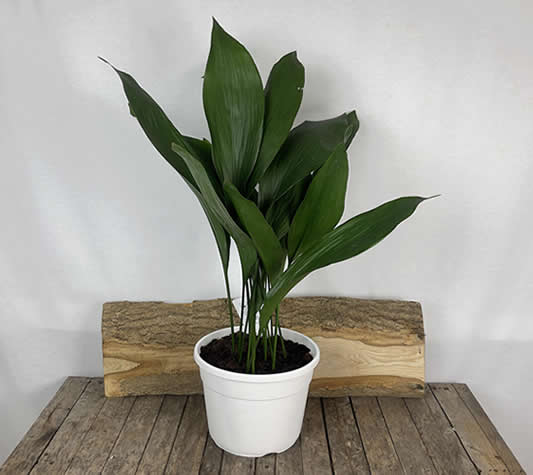
True to its name, this plant is practically indestructible. It’s a slow-growing, shade-tolerant houseplant that thrives on neglect and still manages to look lush and elegant.
With its long, deep green, lance-shaped leaves that can reach up to 24 inches tall, the Cast Iron Plant adds a simple, structural beauty to any corner of your home—even those low-light spots other plants avoid.
Lighting needs
Low light? No problem.
The Cast Iron Plant thrives in dim conditions and can even tolerate full shade, making it ideal for hallways, offices, and north-facing rooms.
That said, it can handle medium, indirect light as well—just avoid placing it in direct sun, which can scorch its leaves.
Soil and watering
This plant prefers a well-draining potting mix—something like a standard indoor plant soil with added perlite for drainage.
It doesn’t need much water and is very forgiving if you forget from time to time.
Wait until the top couple of inches of soil are dry before watering, and make sure your pot has a drainage hole to prevent soggy roots.
Overwatering is one of the only real ways to harm this plant, so when in doubt, let it dry out a little more.
Temperature and humidity
The Cast Iron Plant is happiest in average indoor temperatures between 60°F and 75°F, and it doesn’t demand high humidity.
It tolerates dry air surprisingly well, which makes it perfect for older homes and wintertime care.
Why it’s great for beginners
It’s tough, patient, and practically unbothered by fluctuating conditions.
You don’t have to worry about repotting often, trimming back runners, or babying it with humidity.
This is a truly “set-it-and-forget-it” plant that keeps on growing.
If you’re just starting out or want a low-effort option for a shady corner, the Cast Iron Plant is a no-brainer.
Chinese Evergreen (Aglaonema)
If you’re looking for a houseplant that combines beauty with serious resilience, the Chinese Evergreen is a standout choice.
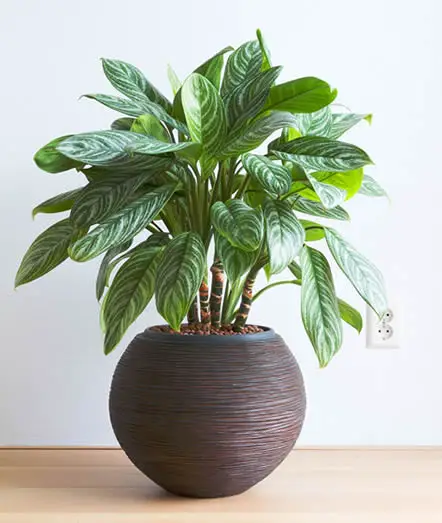
Known for its lush, patterned leaves in shades of green, silver, and even pink or red, Aglaonema is as decorative as it is dependable.
It’s often called one of the most adaptable houseplants—and with good reason.
Whether you have bright light or a low-light corner, this plant is more than happy to settle in and grow.
Lighting needs
Chinese Evergreens are extremely tolerant of different lighting conditions.
Most varieties do best in medium to low indirect light, making them perfect for shady corners or office desks.
If you have a colorful variety with pink or red tones, it may need a bit more light to keep its vibrant hues. Avoid harsh direct sunlight, which can cause leaf burn.
Soil and watering
A well-draining potting mix is best—something designed for houseplants with added perlite or sand to help with airflow.
Water your Chinese Evergreen when the top inch or so of soil feels dry.
It doesn’t like to sit in soggy soil, so be sure your pot drains freely and never let it stand in water.
During winter, you’ll want to reduce watering as the plant slows down and uses less moisture.
Temperature and humidity
This plant loves a warm, steady environment.
Keep it in a spot that stays between 65°F and 80°F, and avoid cold drafts or sudden temperature drops.
It also enjoys moderate humidity, but it won’t complain in average household conditions. If you notice browning tips, a little misting or a nearby pebble tray can help.
Why it’s great for beginners
Chinese Evergreen is the definition of low-maintenance.
It forgives occasional missed waterings, tolerates dim spaces, and still manages to look full and fresh.
It’s also not prone to pests or diseases, which means less stress for you. If you’re just starting out or want a stress-free beauty for your space, this one’s a solid win.
Corn Plant (Dracaena fragrans)
Don’t let the name fool you—Corn Plant isn’t something you’ll harvest in the kitchen.
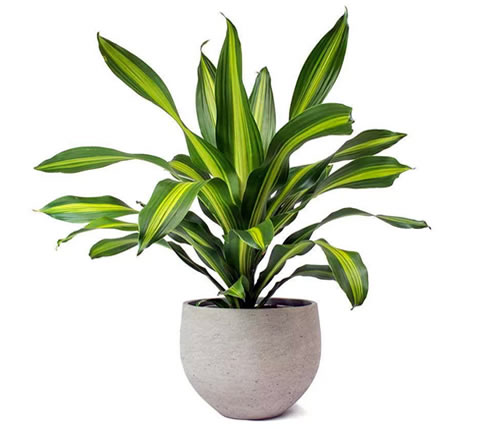
Instead, it’s a tall, stately houseplant with thick canes and wide, arching leaves that resemble the top of a cornstalk.
It’s one of the most popular indoor Dracaena varieties, and for good reason: it’s low-maintenance, tough, and makes a big visual impact with minimal effort.
Over time, Corn Plants can grow several feet tall indoors, adding a strong vertical element to your plant collection.
Lighting needs
Corn Plants prefer bright, indirect light but can adapt to lower light conditions.
If you want to keep the leaf color bold—especially on variegated varieties—aim for filtered sunlight near an east- or west-facing window.
Avoid prolonged direct sun, which can scorch the foliage. In lower light, growth will slow, but the plant will continue to survive quite comfortably.
Soil and watering
Use a well-draining potting mix—something slightly loamy but not dense. A regular indoor mix with a bit of added perlite or sand will do the job.
Water when the top 1–2 inches of soil feel dry, and be sure to allow any excess water to drain away.
The Corn Plant is sensitive to overwatering, so don’t let it sit in soggy soil or standing water.
One useful tip: these plants can be sensitive to fluoride and salts in tap water, which may cause brown leaf tips.
If you notice this happening, try using filtered or distilled water.
Temperature and humidity
Keep your Corn Plant in temperatures between 60°F and 75°F. It enjoys average household humidity, but dry indoor air (especially in winter) may cause the leaf tips to brown.
A little misting or a pebble tray nearby can help if needed.
Why it’s great for beginners
This plant is easy to care for, visually striking, and can grow into a large floor plant over time—without needing too much attention.
It’s not fussy about humidity, doesn’t need constant repotting, and tolerates a range of light levels.
If you want something tall and tropical-looking without the maintenance, the Corn Plant is an excellent choice.
Dragon Tree (Dracaena marginata)
With its long, slender stems and spiky tufts of sword-like leaves edged in red, the Dragon Tree is one of those plants that looks dramatic without being high-maintenance.

Native to Madagascar, this member of the Dracaena family brings height, color, and an architectural edge to any room.
It’s often used as a statement plant in minimalist interiors or grouped with other leafy companions to add vertical interest.
Lighting needs
Dragon Trees are flexible when it comes to lighting.
They grow best in bright, indirect light but can also tolerate lower light conditions.
However, their signature red-edged leaves tend to lose their intensity in very low light.
If you want the color to pop, give it a spot near a sunny window—just out of reach of harsh direct sun, which can scorch the foliage.
Soil and watering
Use a well-draining potting mix, preferably one designed for houseplants or tropical plants.
Allow the top 1–2 inches of soil to dry out before watering.
One of the most common mistakes with Dragon Trees is overwatering—these plants are prone to root rot if left sitting in soggy soil.
Always use a pot with drainage holes and empty any saucers after watering.
This plant is also sensitive to salts and chemicals in tap water, which may cause the leaf tips to turn brown.
If that’s a concern, consider using distilled or filtered water.
Temperature and humidity
Keep your Dragon Tree in a warm environment, ideally between 65°F and 80°F.
It doesn’t require high humidity and generally does just fine in average household conditions.
However, if you notice crispy tips in the winter months, a bit of extra humidity may help.
Why it’s great for beginners
This plant looks exotic but couldn’t be easier to care for.
It adapts to a variety of indoor conditions, grows slowly but steadily, and only needs occasional watering.
Plus, it’s forgiving if you forget to water it once in a while.
If you’re looking for a plant that adds height and flair with minimal effort, the Dragon Tree is a fantastic choice.
English Ivy (Hedera helix)
English Ivy is a classic trailing plant that brings a traditional, timeless look to indoor spaces with its elegant, lobed leaves and fast-growing vines.
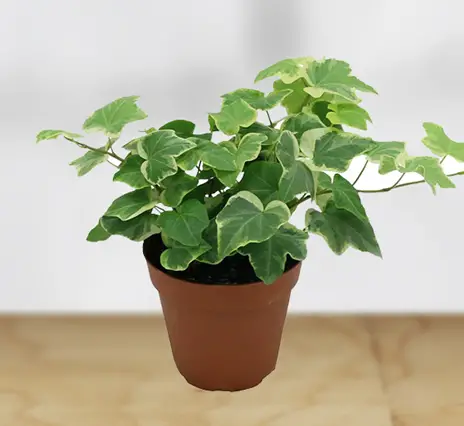
It’s often seen tumbling from hanging baskets, cascading off shelves, or trained to climb trellises and moss poles.
Lighting needs
This plant does best in bright, indirect light but can adapt to medium light levels, especially in cooler rooms.
Avoid strong direct sunlight, which can scorch the foliage and cause crisp brown patches.
Soil and watering
Plant it in well-draining potting soil and keep the mix consistently moist, allowing the top inch to dry out slightly between waterings.
English Ivy enjoys a bit more humidity than most, so if you notice browning leaf edges, mist it regularly or place it near a pebble tray.
Temperature and humidity
It prefers cooler household temperatures between 50°F and 70°F and should be kept away from heat sources and cold drafts.
Average room humidity is usually enough, but dry winter air may require extra moisture.
Why it’s great for beginners
Indoors, it responds well to regular pruning, which helps control growth and encourages fuller, bushier vines.
With the right care, this plant can grow quickly and provide a beautifully trailing, ivy-covered look year-round.
Fiddle Leaf Fig (Ficus lyrata)
Few houseplants make a visual statement like the Fiddle Leaf Fig, with its broad, glossy, violin-shaped leaves and tall, upright form.
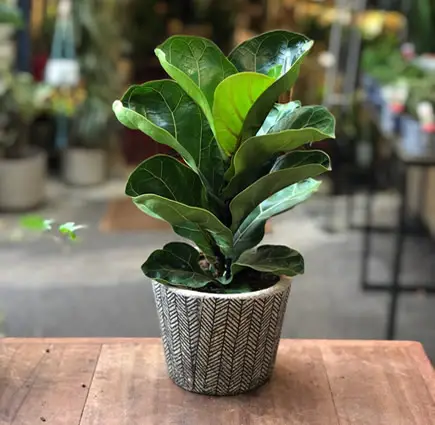
This plant has become a favorite in interior design thanks to its bold foliage and clean, architectural lines.
Lighting needs
To thrive, it needs bright, indirect light and will struggle in dim spaces or areas with inconsistent lighting.
A spot near a sunny window that gets filtered light throughout the day is ideal, but avoid direct rays that can burn its leaves.
Soil and watering
Use a rich, well-draining potting mix and water when the top inch of soil is dry, letting excess water fully drain from the pot.
Fiddle Leaf Figs are prone to root rot if overwatered, so always check the soil before watering.
Temperature and humidity
They prefer a warm, stable environment—ideally between 60°F and 75°F—and don’t respond well to sudden temperature changes or drafts.
Humidity helps keep their broad leaves healthy and free of brown tips, so consider misting or placing a humidifier nearby in winter.
Why it’s great for beginners
This plant can be a little sensitive at first, but once settled in, it grows steadily and can reach impressive indoor heights over time.
If you’re up for just a little more attention and want a bold, sculptural plant, the Fiddle Leaf Fig is absolutely worth it.
Golden Pothos (Epipremnum aureum)
Golden Pothos is one of the most popular beginner houseplants for a reason—it’s hardy, fast-growing, and almost impossible to kill.
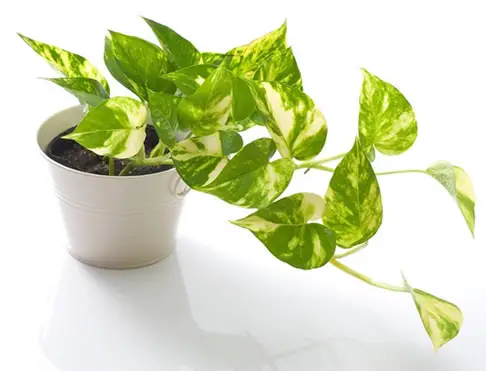
With its heart-shaped, green-and-gold marbled leaves and graceful trailing vines, this plant adds effortless greenery to shelves, hanging baskets, and tabletops.
Lighting needs
Golden Pothos thrives in bright, indirect light but is highly adaptable and will also tolerate low-light areas.
The variegation may fade in very dim conditions, but the plant will still grow steadily.
Avoid harsh direct sun, which can burn the foliage.
Soil and watering
This plant prefers a well-draining potting mix and should be watered when the top inch or two of soil feels dry.
It’s better to underwater than overwater—Pothos is prone to root rot if left sitting in soggy soil.
Let any excess water drain completely, and never let it sit in a saucer of water.
Temperature and humidity
Golden Pothos grows well in typical indoor temperatures between 60°F and 85°F.
It tolerates a range of humidity levels, though it prefers moderate humidity if possible.
It will still perform well in dry indoor air, but if the leaf tips start to brown, a little misting can help.
Why it’s great for beginners
Golden Pothos is incredibly low-maintenance and bounces back quickly from neglect.
It can grow several feet long, is easily pruned, and even roots easily in water for quick propagation.
If you’re new to houseplants or want something reliable and lush, you can’t go wrong with this tried-and-true favorite.
Hoya (Hoya carnosa and other varieties)
Hoya, often called the wax plant, is a beautiful trailing or climbing houseplant with thick, waxy leaves and clusters of star-shaped, fragrant flowers.
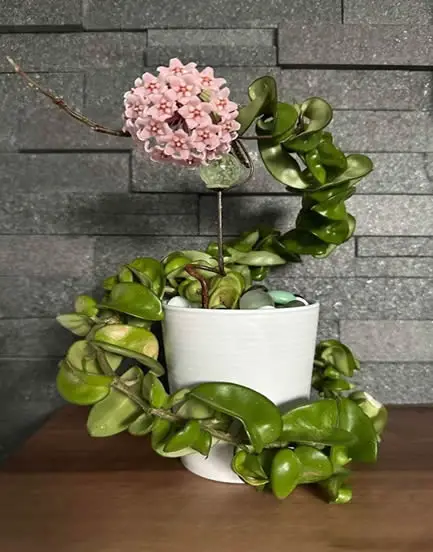
These semi-succulent plants are long-lived, forgiving, and rewarding—especially when they bloom.
The most popular Hoya, especially for hanging baskets, in the Hindu Rope Plant.
Lighting needs
Hoyas love bright, indirect light and will grow best near an east- or west-facing window.
They can tolerate a bit of direct morning sun but should be protected from hot afternoon rays.
Insufficient light won’t kill the plant, but it may delay or prevent flowering.
Soil and watering
A light, well-draining mix is key—use a cactus or succulent blend, or a chunky aroid-style mix with bark, perlite, and a bit of potting soil.
Let the soil dry out between waterings, as Hoyas don’t like to stay wet for long.
Water thoroughly, then allow excess moisture to drain completely.
Temperature and humidity
Hoyas thrive in temperatures between 60°F and 85°F and appreciate higher humidity.
They’ll still grow in standard indoor air, but flowering and new growth may improve with regular misting or a humidifier.
Why it’s great for beginners
Hoyas are slow to complain, slow to grow, and full of personality.
They tolerate occasional forgetfulness, rarely suffer from pests, and will reward you with trailing vines and (if you’re lucky) fragrant blooms.
Once settled, they’re wonderfully hands-off and can live for decades.
Jade Plant (Crassula ovata)
The Jade Plant is a timeless succulent with thick, glossy, oval-shaped leaves and sturdy, tree-like stems that give it a bonsai-like appearance as it matures.
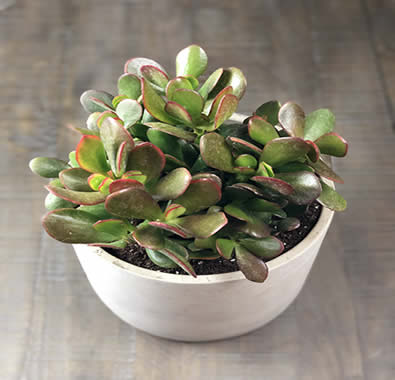
Sometimes called the “money plant,” it’s believed to bring good luck and prosperity—making it a favorite for both beginners and gift-givers.
Lighting needs
Jade Plants prefer bright light and will do best near a south- or west-facing window where they can soak up a few hours of direct sun daily.
Too little light will cause slow, leggy growth, while adequate sunlight helps the leaves stay compact and sometimes gives them a reddish tint around the edges.
Soil and watering
This is a true succulent and needs a gritty, well-draining soil mix.
A cactus or succulent blend works well, or you can make your own with potting soil, coarse sand, and perlite.
Allow the soil to dry out completely between waterings and avoid letting water sit in the pot’s saucer.
Overwatering is the fastest way to harm this plant.
Temperature and humidity
Jade Plants like average indoor temperatures between 60°F and 75°F.
They don’t require high humidity and are happy in dry household air.
Avoid exposing them to freezing temperatures or sudden cold drafts.
Why it’s great for beginners
Jade is a tough, long-lived plant that doesn’t demand much.
As long as you don’t overwater it, it will grow steadily and can be pruned and shaped as it matures.
It’s a great choice for sunny windowsills, and its low-maintenance care routine makes it ideal for new plant owners.
Lucky Bamboo (Dracaena sanderiana)
Lucky Bamboo is often associated with good fortune, especially in Feng Shui, and it’s a unique and eye-catching plant that grows in water or soil.
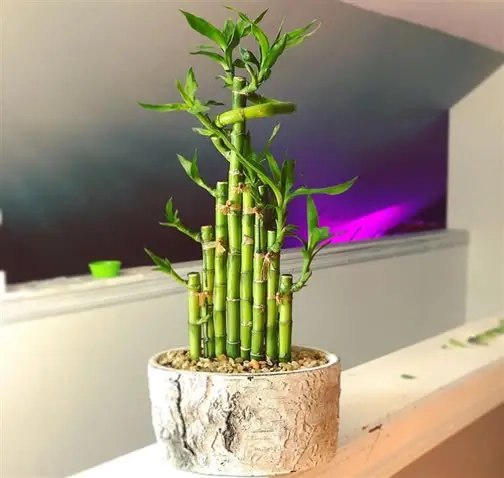
Despite its name, it’s not a true bamboo—it’s actually a species of Dracaena—but it mimics bamboo’s look with its smooth, upright stalks and lush green leaves.
Lighting needs
This plant does best in bright, filtered light but will tolerate low-light conditions, making it a great option for offices or shaded spots.
Direct sunlight should be avoided, as it can scorch the leaves and cause yellowing.
Soil and watering
Lucky Bamboo can grow in either water or soil.
If growing in water, use distilled or filtered water and change it every two weeks to prevent bacterial growth.
Keep the roots covered but not fully submerged, and rinse the container periodically.
If growing in soil, use a loose, well-draining mix and water when the top inch feels dry.
Temperature and humidity
It thrives in warm, humid environments between 65°F and 90°F.
Keep it away from drafts, air conditioners, and cold windows, especially in winter.
It enjoys moderate humidity but typically does well in standard indoor conditions.
Why it’s great for beginners
Lucky Bamboo is one of the easiest plants to care for—it’s adaptable, fast-growing, and visually striking with its sculptural shapes and twistable stems.
Whether in water or soil, it requires very little attention and brings a fresh, calming presence to any room.
Monstera Deliciosa
Monstera Deliciosa, often called the Swiss Cheese Plant, is a bold and iconic houseplant known for its large, glossy leaves and signature natural holes, or fenestrations.
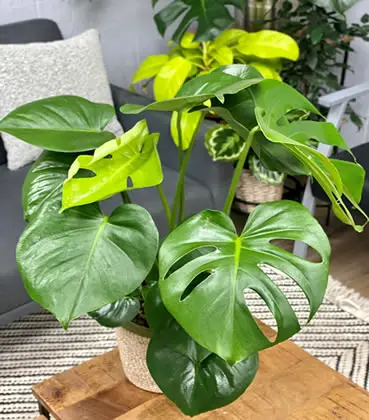
It brings a lush, tropical vibe to any room and grows into a dramatic centerpiece with surprisingly easy care.
Lighting needs
Monsteras prefer bright, indirect light and will grow best near a window where they receive gentle morning sun or filtered daylight.
Too much direct sun can scorch the leaves, while too little light may prevent new leaves from developing their characteristic splits and holes.
Soil and watering
Use a chunky, well-draining soil mix—something airy with potting soil, perlite, and bark works beautifully.
Water thoroughly when the top two inches of soil feel dry, and always allow excess water to drain out of the pot.
Overwatering can lead to root rot, so avoid letting it sit in soggy soil.
Temperature and humidity
This plant enjoys warmth and humidity, ideally between 65°F and 85°F.
While it adapts to average household humidity, it will truly thrive with a bit of extra moisture in the air, especially during dry seasons.
Why it’s great for beginners
Despite its exotic appearance, Monstera is surprisingly low-maintenance.
It’s fast-growing, easy to propagate, and very forgiving if you occasionally forget to water.
If you’re looking for a show-stopping plant that’s beginner-friendly, Monstera Deliciosa is a top contender.
Nerve Plant (Fittonia albivenis)
The Nerve Plant is a compact, colorful houseplant with striking vein patterns that run through its leaves—typically in white, pink, or red.
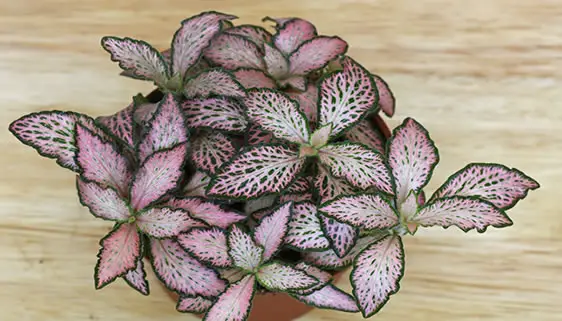
Its vibrant contrast and low-growing habit make it a perfect accent plant for terrariums, small pots, or bright tabletops.
Lighting needs
Fittonia prefers bright, indirect light but will tolerate medium to low light if needed.
Harsh direct sun can scorch its delicate leaves, while too little light may cause its vivid colors to fade.
Soil and watering
Use a rich, well-draining potting mix and keep the soil consistently moist, but not soggy.
Nerve Plants are sensitive to drought—if they dry out too much, they’ll dramatically wilt, though they usually bounce back quickly after a good drink.
Temperature and humidity
This tropical plant loves warmth and humidity, with ideal temperatures ranging from 65°F to 80°F.
It thrives in steamy bathrooms, terrariums, or near a humidifier.
If the leaf edges begin to crisp, it likely needs more moisture in the air.
Why it’s great for beginners
While a little thirstier than some other easy-care plants, the Nerve Plant communicates clearly when it needs attention.
Its dramatic wilt is easy to spot and just as quick to fix.
If you’re looking for something small, bold, and expressive, Fittonia is a rewarding plant to grow.
Norfolk Island Pine (Araucaria heterophylla)
The Norfolk Island Pine brings the elegance of a soft, indoor-friendly conifer into your home with its symmetrical branches and feathery, needle-like leaves.
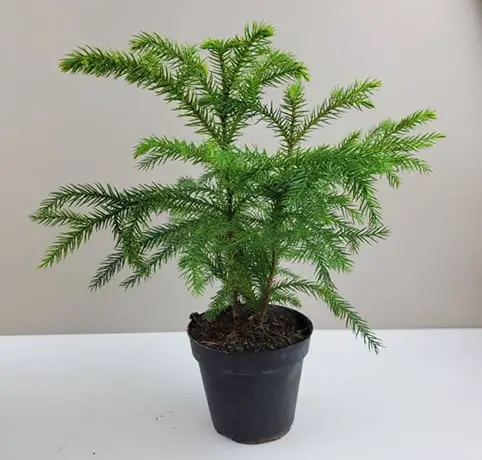
Though it looks like a miniature Christmas tree, it’s not a true pine—but it adds that cozy, evergreen feel year-round.
Lighting needs
This plant enjoys bright, indirect light and will thrive near a window that gets several hours of filtered sun.
While it can tolerate a bit of direct morning sun, avoid strong afternoon rays, which can dry out the foliage. Low light may cause it to grow unevenly or lose its lower branches over time.
Soil and watering
Plant it in a well-draining potting mix—something rich but airy. Water when the top inch or two of soil feels dry, and be careful not to let the roots sit in standing water.
These plants are somewhat drought-tolerant, but they dislike extremes—keep it evenly moist without overdoing it.
Temperature and humidity
Norfolk Island Pines prefer cooler temperatures than most tropical houseplants, ideally between 60°F and 75°F.
They’re happiest in medium to high humidity and may struggle in very dry indoor air. If the leaf tips turn brown, misting or a humidifier can help.
Why it’s great for beginners
Though it’s a little more sensitive to dry air, this plant is generally easy to care for and adds a unique, structured look to your space.
It grows slowly, doesn’t need frequent repotting, and can even be decorated during the holidays. If you want something evergreen and elegant, this one is a great fit.
Parlor Palm (Chamaedorea elegans)
The Parlor Palm is a timeless indoor plant known for its elegant fronds and soft, tropical presence—without the high-maintenance reputation of other palms.
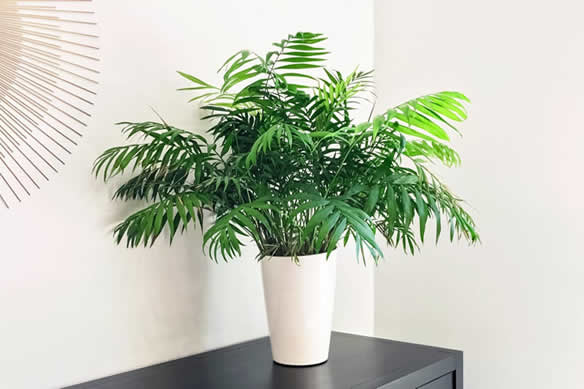
It’s been a staple in homes since the Victorian era, earning its name from being a favorite for shaded parlor rooms.
Lighting needs
This plant thrives in low to moderate indirect light, making it ideal for spots that don’t get much sun.
Too much direct sunlight can scorch the fronds, so it’s best kept a few feet back from a bright window or in a softly lit corner.
Soil and watering
Use a lightweight, well-draining potting mix and water when the top inch of soil has dried out.
Parlor Palms like to stay evenly moist during the growing season, but they can tolerate brief dry periods and don’t like to sit in soggy soil.
Temperature and humidity
Keep your Parlor Palm in a room between 65°F and 80°F, and avoid placing it near cold drafts or heating vents.
It does fine in average household humidity but will appreciate an occasional misting or pebble tray, especially in dry environments.
Why it’s great for beginners
This plant is one of the easiest indoor palms to grow, requiring minimal care while providing a soft, full look.
It’s also non-toxic to pets, which makes it a safe and graceful option for any room in the house.
Peace Lily (Spathiphyllum)
The Peace Lily is one of the most popular indoor plants for a reason—it’s elegant, easy to grow, and even lets you know when it’s thirsty.
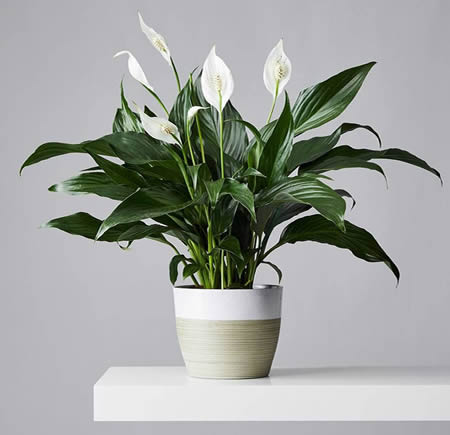
With its dark green leaves and striking white spathes (which look like flowers), it adds a graceful touch to any room.
Lighting needs
Peace Lilies thrive in bright, indirect light but will also tolerate low-light conditions, though they may bloom less often.
Avoid strong direct sunlight, which can scorch the leaves and cause them to fade.
Soil and watering
Use a rich, well-draining potting mix and water when the top inch of soil feels dry.
The plant will droop noticeably when it needs water, but don’t make it a habit—frequent wilting can weaken the plant over time.
Be sure to let excess water drain out completely and avoid letting it sit in water.
Temperature and humidity
Keep Peace Lilies in temperatures between 65°F and 80°F, and away from cold drafts.
They enjoy moderate to high humidity and benefit from regular misting or a nearby humidifier, especially in drier seasons.
Why it’s great for beginners
This plant is incredibly communicative, forgiving, and resilient.
It’s also known for purifying indoor air and offering a subtle, peaceful beauty with its occasional blooms.
Peperomia (Peperomia spp.)
Peperomia is a diverse genus of small, compact houseplants with an incredible variety of leaf shapes, colors, and textures. F
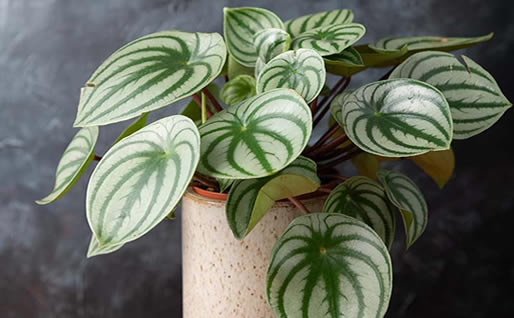
rom ripple-leafed varieties to ones that look almost succulent, there’s a Peperomia for everyone.
Lighting needs
Most Peperomia varieties prefer medium to bright, indirect light.
While they tolerate lower light, their unique leaf colors and patterns often fade without enough brightness.
Avoid placing them in direct sun, which can scorch their leaves.
Soil and watering
Use a light, well-draining mix—something similar to a cactus or orchid blend works well.
Let the top inch of soil dry out before watering.
These plants store some water in their fleshy leaves and don’t like to stay wet for long.
Temperature and humidity
They prefer warm, stable indoor temperatures between 65°F and 80°F.
Peperomia adapts well to household humidity but appreciates a little extra moisture in the air, especially if kept near heaters or during winter.
Why it’s great for beginners
Peperomia plants are low-maintenance, compact, and come in so many attractive varieties that it’s hard to stop at just one.
They don’t need much space or water and are generally pest-resistant and easy to keep looking great.
Philodendron (Philodendron hederaceum and hybrids)
Philodendrons are classic indoor plants loved for their heart-shaped leaves and trailing or climbing growth habits.
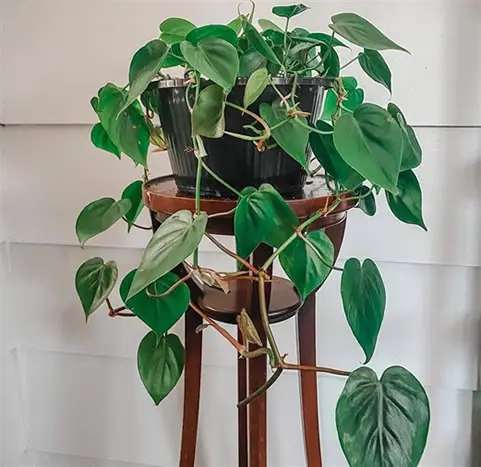
They’re fast-growing, forgiving, and available in a range of beautiful varieties, from soft green to deep velvety tones.
Lighting needs
These plants thrive in bright, indirect light but also adapt well to lower light environments.
In lower light, growth may slow slightly, but the plant will still remain healthy.
Avoid direct sunlight, which can scorch the leaves.
Soil and watering
Plant Philodendrons in a loose, well-draining potting mix—something slightly airy that retains some moisture but doesn’t stay soggy.
Water when the top inch of soil feels dry. If the leaves start to droop slightly, that’s usually a sign it’s time for a drink.
Temperature and humidity
They prefer temperatures between 65°F and 80°F and do well in normal household humidity.
If you want faster growth or fuller vines, a bit of extra humidity can help, especially in winter.
Why it’s great for beginners
Philodendrons are quick to adapt, easy to propagate, and resilient to occasional neglect.
Whether you want a trailing shelf plant or something that climbs a moss pole, this one makes indoor greenery feel easy and fun.
Ponytail Palm (Beaucarnea recurvata)
Despite its name and its palm-like appearance, the Ponytail Palm is actually a drought-tolerant succulent with a thick, bulbous base that stores water and a cascade of thin, arching leaves.
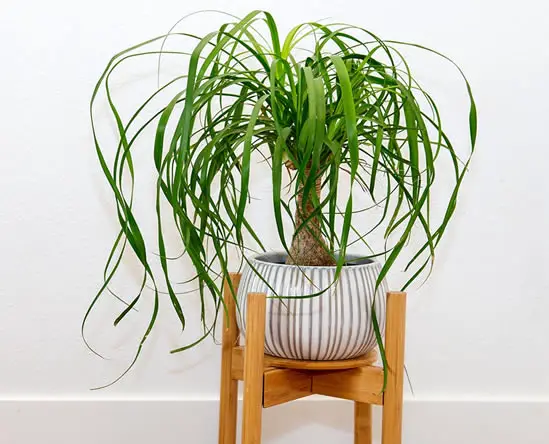
It’s quirky, stylish, and almost impossible to overwater.
Lighting needs
Bright, indirect light is ideal, though it can also adapt to direct sun and medium light settings.
The more light it receives, the more vigorous and full the growth will be.
Soil and watering
Use a sandy, well-draining succulent or cactus mix. Water thoroughly, then allow the soil to dry out completely before watering again.
Its bulb-like base retains water, so overwatering is the biggest risk—when in doubt, wait a few more days.
Temperature and humidity
Ponytail Palms love warmth and prefer temperatures between 65°F and 85°F.
They’re totally fine in low humidity and thrive in dry indoor air.
Why it’s great for beginners
This plant is nearly carefree and has a sculptural quality that works beautifully in modern interiors.
With very little maintenance, it continues to grow slowly and gracefully, making it ideal for new plant parents with busy lives.
Prayer Plant (Maranta leuconeura)
The Prayer Plant is named for the way its leaves fold upward at night, like hands in prayer.
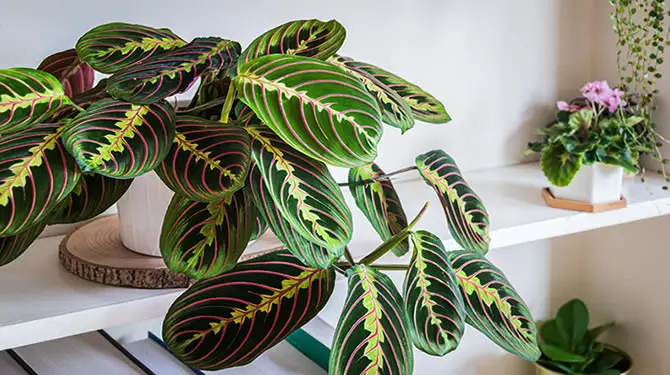
With its striking vein patterns and vibrant color combinations—often featuring reds, greens, and creams—it brings a bold splash of personality to any plant collection.
Lighting needs
Prayer Plants do best in bright, indirect light but can tolerate medium light as well.
Too much direct sun can fade the colors or cause the leaves to curl, so filtered light is ideal.
Soil and watering
Use a rich, well-draining soil mix that holds some moisture without becoming soggy.
Keep the soil evenly moist, but not soaked—these plants don’t like to dry out completely or sit in water. Water with filtered or distilled water if your tap water is high in salts or minerals.
Temperature and humidity
They prefer temperatures between 65°F and 80°F and high humidity.
Dry air can cause brown leaf tips, so regular misting or a humidifier will help keep your Prayer Plant looking its best.
Why it’s great for beginners
Although they need a little more attention to humidity and watering, Prayer Plants are rewarding, expressive, and full of character.
Their unique leaf movements and vivid patterns make them a favorite for beginners who want something a bit more interactive.
Rubber Plant (Ficus elastica)
The Rubber Plant is a striking, low-maintenance houseplant with broad, glossy leaves that range from deep green to burgundy, depending on the variety.
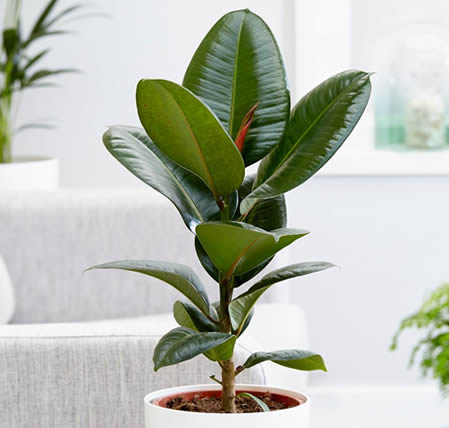
It can grow into an impressive indoor tree with the right care, making it perfect for anyone looking to add height and drama to their space.
Lighting needs
This plant thrives in bright, indirect light, though it can handle some lower light conditions.
If you want bold color and faster growth, give it a spot near a sunny window—just avoid harsh direct light that can scorch the leaves.
Soil and watering
Rubber Plants like a well-draining, slightly aerated potting mix.
Let the top couple of inches of soil dry out between waterings.
Be careful not to overwater—root rot is one of the few things that can set this plant back.
Temperature and humidity
Ideal temperatures range from 60°F to 80°F, and it prefers consistent warmth.
It tolerates average household humidity well but will appreciate a little misting during especially dry seasons.
Why it’s great for beginners
With its bold foliage, forgiving nature, and air-purifying qualities, the Rubber Plant is a rewarding choice for anyone starting out.
It adapts well to indoor life and grows steadily with minimal fuss.
Snake Plant (Dracaena trifasciata)
The Snake Plant, also known as Mother-in-Law’s Tongue, is one of the toughest and most beginner-friendly houseplants you can own.
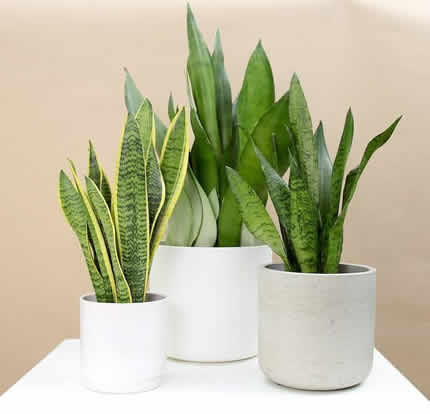
With tall, upright leaves in variegated green and yellow stripes, it adds a striking, sculptural element to your space while asking for very little in return.
Lighting needs
Snake Plants are extremely adaptable and can tolerate everything from bright, indirect light to low-light corners.
While they grow faster in bright light, they’ll still survive and look great in rooms with minimal sun exposure.
Soil and watering
This plant needs well-draining soil—use a cactus or succulent mix to prevent water retention.
Let the soil dry out completely between waterings, and be very careful not to overwater.
If there’s one way to hurt a Snake Plant, it’s with soggy soil.
Temperature and humidity
They prefer average indoor temperatures between 60°F and 80°F and aren’t picky about humidity.
They’ll even tolerate dry air and inconsistent care, making them a great fit for nearly any indoor environment.
Why it’s great for beginners
Snake Plants are as low-maintenance as they come.
They’re slow growers, forgiving of neglect, and help clean the air.
If you want a stylish plant that thrives on being left alone, this one’s your best friend.
Schefflera (Umbrella Plant)
The Schefflera, or Umbrella Plant, gets its name from the way its leaflets fan out like spokes on an umbrella.
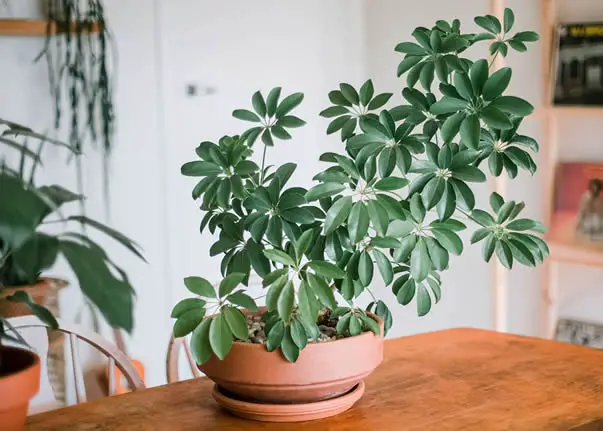
It’s a fast-growing, easy-to-care-for houseplant with glossy green foliage that adds instant vibrancy and structure to any room.
Lighting needs
Scheffleras prefer bright, indirect light and grow quickly in well-lit spaces.
They’ll tolerate medium light but may become leggy or grow slower without enough sun.
Avoid prolonged direct sunlight, which can cause leaf burn.
Soil and watering
Plant in a lightweight, well-draining potting mix and water when the top inch or two feels dry.
Allow the soil to dry out slightly between waterings and never let the pot sit in standing water.
Yellow leaves may indicate overwatering or a lack of drainage.
Temperature and humidity
These plants enjoy temperatures between 60°F and 75°F and adapt well to average indoor humidity.
Keep them away from drafts or sudden temperature changes, which can cause leaf drop.
Why it’s great for beginners
Scheffleras are fast-growing, low-fuss, and easy to shape or prune as they mature.
They’re a great choice for beginners who want a larger plant that makes an impact without needing constant attention.
Spider Plant (Chlorophytum comosum)
The Spider Plant is a lively, easy-going houseplant with arching green-and-white striped leaves and adorable baby offshoots that dangle like little spiders on a web.
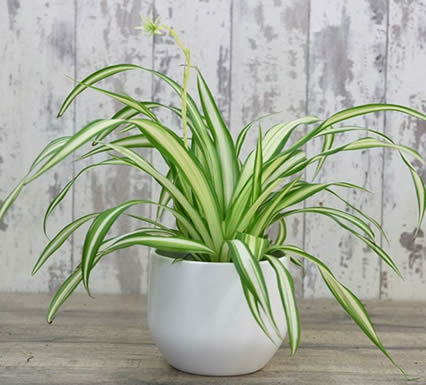
It’s a favorite for hanging baskets and shelves, thanks to its playful shape and fast-growing nature.
Below are the basic care needs of the Spider Plant but if you want more detailed instructions read our article Spider Plant Care: How to Grow a Happy, Trailing Houseplant.
Lighting needs
Spider Plants thrive in bright, indirect light but can also handle medium and even lower light levels.
Too much direct sun may cause the leaves to scorch or fade, especially in variegated varieties.
Soil and watering
Use a standard, well-draining potting mix and water when the top inch of soil feels dry.
This plant appreciates regular watering but will tolerate a missed watering here and there.
Avoid overwatering, as soggy soil can lead to root rot or browning leaf tips.
Temperature and humidity
Spider Plants enjoy temperatures between 60°F and 80°F and do well in average humidity.
Dry air can cause brown tips, so occasional misting or using distilled water (if your tap water is high in minerals) can help keep it looking fresh.
Why it’s great for beginners
Spider Plants are resilient, adaptable, and easy to propagate from their many baby “spiderettes.”
They’re also non-toxic to pets and children, making them a great addition to any household.
Split Leaf Philodendron (Thaumatophyllum bipinnatifidum)
Often mistaken for its Monstera cousin, the Split Leaf Philodendron is a bold, tropical houseplant with deeply lobed leaves that bring instant jungle vibes to any room.
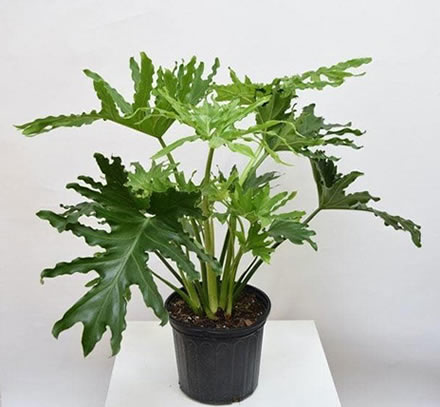
It’s sometimes sold under the older name Philodendron selloum, but no matter the label, it’s easy to love and easy to grow.
Below are the basic care needs of the Golden Pothos but if you want more detailed instructions read our article Philodendron Care: How to Grow These Versatile, Lush Houseplants Indoors
Lighting needs
This plant does best in bright, indirect light but will tolerate medium-light areas too.
Avoid harsh direct sunlight, which can burn the leaves, though a little filtered morning sun is welcome.
Soil and watering
Plant it in a loose, well-draining mix—something rich but airy.
Water when the top two inches of soil feel dry, and let any extra water drain away completely.
This plant enjoys consistent moisture but doesn’t like wet feet.
Temperature and humidity
Ideal temperatures are between 65°F and 80°F, and it prefers a little humidity, though it’s pretty adaptable.
In very dry environments, a humidifier or occasional misting will help maintain its glossy foliage.
Why it’s great for beginners
This plant grows large and dramatic with minimal fuss.
It doesn’t need high humidity, grows steadily with just basic care, and makes a bold statement in any indoor space.
String of Pearls (Senecio rowleyanus)
String of Pearls is one of the most eye-catching succulents thanks to its cascading strands of perfectly round, bead-like leaves.
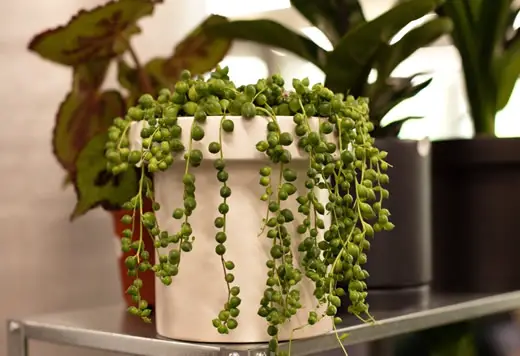
This whimsical plant adds instant charm to shelves and hanging planters, and with the right light, it grows fast and full.
Lighting needs
Bright, indirect light is ideal—think a sunny windowsill with filtered rays.
While it can handle some direct morning sun, harsh afternoon sunlight may scorch the pearls, and too little light can cause the strands to become sparse and leggy.
Soil and watering
Use a gritty, fast-draining cactus or succulent mix to prevent root rot.
Let the soil dry out completely between waterings, and always err on the side of underwatering rather than overwatering.
The plant stores moisture in its leaves and can go several weeks without a drink.
Temperature and humidity
String of Pearls loves warm, dry conditions and grows best between 70°F and 85°F.
It doesn’t require humidity and actually prefers drier air, making it ideal for sunny, low-humidity spaces.
Why it’s great for beginners
As long as you don’t overwater it, this plant is incredibly easy to grow.
It propagates easily from cuttings, and its trailing form makes a unique and rewarding addition to any succulent collection.
String of Pearls are also extremely easy to propagate which is a great way for beginner houseplant owners to get fast and easy wins at there first attempt at growing new plants form existing ones!
Swiss Cheese Plant (Monstera adansonii)
The Swiss Cheese Plant is known for its small, heart-shaped leaves dotted with natural holes—a quirky and lovable feature that earns it its name.
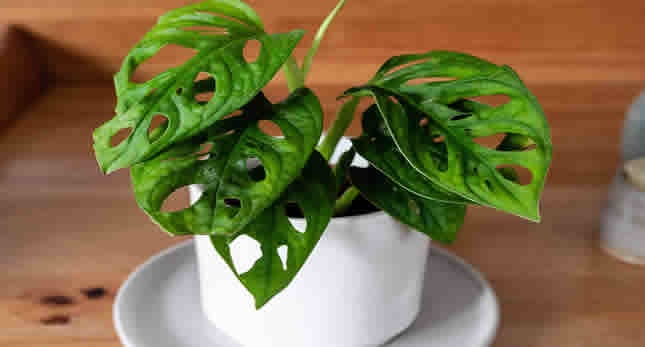
It’s fast-growing, vining, and just as easy to care for as it is fun to look at.
Lighting needs
Bright, indirect light is best.
Too much direct sun can burn the delicate foliage, while low light will reduce the number of holes in new leaves and slow down growth.
Soil and watering
Use a loose, well-draining soil mix that retains some moisture but drains freely—an aroid mix with bark and perlite works great.
Water when the top inch of soil is dry, and let excess water drain completely. These plants like consistent moisture but not soggy roots.
Temperature and humidity
They thrive between 65°F and 80°F and love higher humidity levels.
A humidifier, regular misting, or placing the plant in a bathroom with bright light can encourage lusher growth and bigger leaves.
Why it’s great for beginners
Swiss Cheese Plants grow quickly, respond well to pruning, and are easy to propagate.
They bring a jungle feel to any indoor space without requiring a lot of effort.
Syngonium (Arrowhead Plant)
Syngonium, also known as the Arrowhead Plant, is a versatile and beginner-friendly houseplant with arrow-shaped leaves that come in a variety of colors including green, pink, white, and cream.
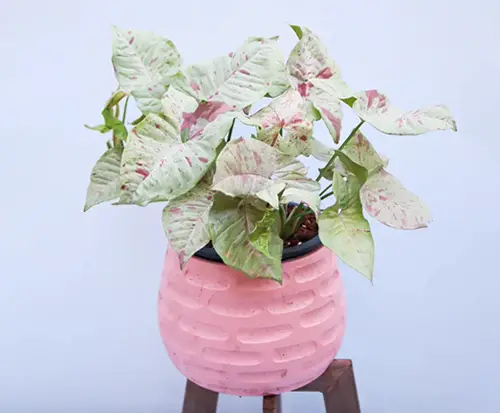
It starts out compact but can trail or climb with age, giving you flexibility in how you style it.
Lighting needs
It thrives in bright, indirect light but also does well in moderate or even lower light conditions.
Variegated varieties may lose their color in deep shade, so aim for a bright spot without direct sun.
Soil and watering
Use a standard, well-draining potting mix and water when the top inch of soil feels dry.
This plant likes consistent moisture but should never be waterlogged.
Allow it to dry slightly between waterings, especially in cooler months.
Temperature and humidity
Syngonium prefers warm, humid conditions and will grow happily in temperatures between 60°F and 80°F.
If you see crispy tips, it may need more humidity—mist it regularly or place it near a pebble tray.
Why it’s great for beginners
It’s forgiving, fast-growing, and easy to shape—let it trail, climb, or stay bushy.
If you want a colorful plant that adapts to many environments, Syngonium is a fantastic pick.
ZZ Plant (Zamioculcas zamiifolia)
The ZZ Plant is practically indestructible, with glossy, deep green leaves and a modern, upright growth habit.
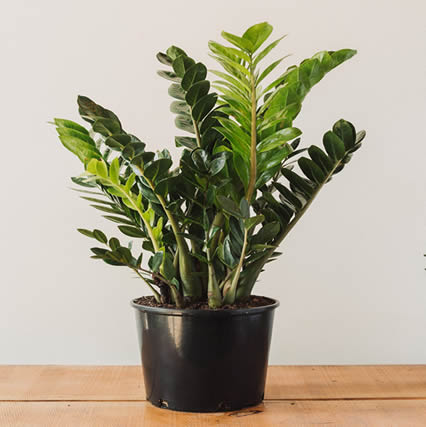
It thrives on neglect and is one of the best options for anyone who travels often or forgets to water.
Lighting needs
ZZ Plants prefer bright, indirect light but are perfectly happy in low-light spaces too.
They’ll grow more slowly in low light but still stay healthy and attractive.
Avoid harsh direct sun, which can scorch the leaves.
Soil and watering
Use a fast-draining potting mix—something similar to a cactus blend—and let the soil dry out completely between waterings.
ZZ Plants store water in their thick rhizomes, so they don’t need frequent watering and are very drought-tolerant.
Temperature and humidity
Average household conditions between 60°F and 75°F are just fine, and they don’t need high humidity.
They’re very low-fuss and not picky about temperature or moisture.
Why it’s great for beginners
ZZ Plants are about as low-maintenance as it gets.
They’re incredibly tolerant of neglect, rarely get pests, and look stylish with minimal effort.
Dieffenbachia (Dumb Cane)
Dieffenbachia is a bold houseplant with large, patterned leaves that bring a lush, tropical feel to any room.
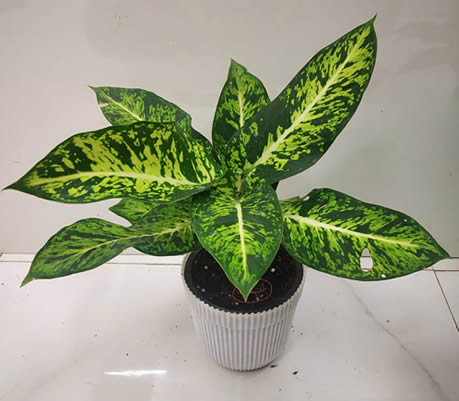
It’s known for its dramatic foliage, often a mix of green, cream, and yellow, and its upright, bushy growth habit.
Lighting needs
It thrives in bright, indirect light and tolerates medium light as well. Avoid direct sunlight, which can scorch its broad leaves.
In too little light, it may grow leggy or lose its vibrant color.
Soil and watering
Use a well-draining, peat-based potting mix and water when the top 1–2 inches of soil feel dry.
It likes consistent moisture but not soggy roots, so be sure your pot has good drainage.
Temperature and humidity
This plant prefers temperatures between 65°F and 80°F and does well with moderate humidity.
It’s sensitive to cold drafts, so keep it away from air conditioners or open windows in winter.
Why it’s great for beginners
It’s easy to care for, visually impressive, and will let you know if something’s off—yellowing leaves are usually a quick fix.
If you want a big, leafy plant that stands out with little effort, Dieffenbachia is a top choice.
Pilea Peperomioides (Chinese Money Plant)
With its round, pancake-shaped leaves and playful, upright growth, the Chinese Money Plant is one of the most charming and popular houseplants around.
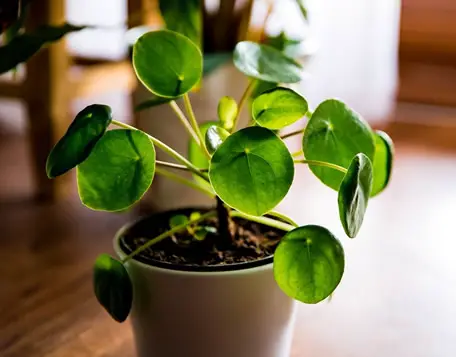
It grows quickly and often produces baby plants you can share or repot.
Lighting needs
It does best in bright, indirect light and will become leggy if it doesn’t get enough.
Rotate your plant regularly to keep its growth even, as it tends to lean toward the light.
Soil and watering
Use a light, well-draining potting mix and water when the top inch of soil is dry.
It’s important to allow the excess water to drain, as this plant doesn’t tolerate soggy soil.
Temperature and humidity
Ideal temperatures are between 60°F and 75°F, and it tolerates standard household humidity well.
It’s not particularly sensitive to moisture in the air, which makes it easy to place anywhere.
Why it’s great for beginners
The Chinese Money Plant is quick to grow, easy to propagate, and very forgiving.
It’s a perfect starter plant for anyone who wants something a little different and loves the idea of passing along “plant pups.”
Final Thoughts
Whether you’re just starting your houseplant journey or looking to expand your collection with fuss-free favorites, these 30 easy-care plants prove that growing a lush, green space doesn’t have to be complicated.
With a little light, the right watering rhythm, and some occasional love, each of these plants will reward you with beauty, growth, and a deeper connection to nature—no green thumb required.
Happy planting! 🌿

